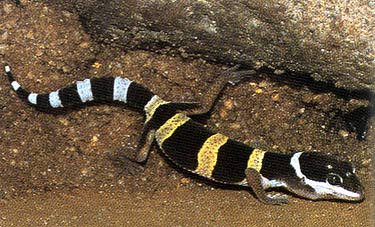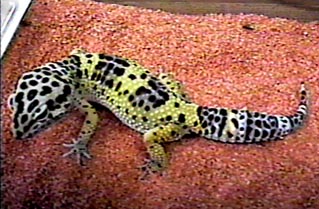|
Juvenile or Hatchling |
The Leopard Gecko |
Adult |
Their scientific name is "Eublelpharis Macularius". Eublelpharis means real or true eyelids. Macularius simply means spotted.
| Origin | Southern Central Asia - Iran, Iraq, Afghanistan, Pakistan and North Western India |
| Natural Habitat | Semi Desert, Scrub Areas, Rocky Outcrops |
| Lifestyle | Nocturnal (active at night), Crepuscular (active at dusk) |
| Eating Habits | Carnivorous, feeding on mostly invertibrates |
| Size | Average 8 to 10 inches. 45 to 65 grams. Rare specimens up to 12 inches - 100 grams. Adult size reached by approx. 18 months. |
| Life Span | Average 18 to 21 years. Rare specimens up to 27years. |
| Physical Characteristics | Wide variety of colors and patterns. Hatchlings/Juveniles are
banded. Banding fading and spots appearing with maturity. Most are yellow with dark brown to black spots and white underside. Short fat tail, short legs and large head. Body is somewhat like a flattened cylinder. Granular scales. Obvious outer Ear. Fleshy tongue - not forked. |
| Distinction of Breed | Unlike most geckos, the leopard gecko has movable eyelids (thus its name Eublelpharis) also unlike most geckos that have lamellae on their toepads (which allows them to climb vertical surfaces, including glass) , Leopard geckos have no lamellae. Instead they have small claws. |
| Defense mechanism | Are known to hiss and take defensive stance. Autotomy - dropping off of tail to hopefully distract predator to enable escape. (Tail will regrow in time but will lack normal markings and will be shorter and less attractive. |
| Temperament | Are known to be very tame, handleable and intelligent. Males are territorial and will fight. Females will sometimes bully smaller geckos, especially in competition for food. |
| Sexing | Males are usually a little larger, have broader heads and thicker necks. Males have bulges at the base of their tail and a V shaped row of preanal pores located between the hind legs. Can be sexually mature as early as 10 months old. |
| Housing | 1 gecko - 10 gallon aquarium tank. (long as opposed to tall)
3 geckos - 20 gallon aquarium tank ( long as opposed to tall) Good fitting Screen top. |
| Substrate | For hatchlings and juveniles use newspaper or paper towels until
at least 6 months old or at least 5 inches long. I recommend using "Calci-Sand" (as that is closest to their natural habitat and Calci-sand as opposed to play sand is actually ground bone/calcium which is actually good for your gecko's calcium supplimentation should they happen to eat any. Avoid: Potting Soil - they may eat the perlite....not good. Cedar or Pine - fumes and resins may be toxic Astroturf - may ingest loose particles or frayed edges, also rough on underbelly. Bark, shavings and mosses - Easily ingested and prone to mold. Looped indoor/outdoor carpeting - loose edge particles may be ingested, and teeth can get caught in fibers. Corncob bedding - too rough on underbelly |
| Landscaping | Rocks, Wood to climb on. Shelter and hide spots. Hide Box, Shed or humidifing box. Should have a separate hide box for each gecko in times of conflict. Humidifing box can be made from a tupperware or butter tub with at least an inch of moistened vermiculite. A hole can be cut (for an entrance)in the side or top of this container. Also a small water dish with a rock, stick or sponge in it so that the crickets can get out. |
| Humidity | Humidity in shed box should be 20 - 30% to aid in shedding skin. Mist vermiculite as needed to maintain humidity. (Leopard gecko will eat shed skin as it is full of vitamins and calcium and is good for your pet) |
| Heating | Leopard Geckos are nocturnal and therefore shun sunlight so
no UV rays are needed. They do not bask. Use regular incandesent bulb (daytime only), ceramic bulb or nocturnal heat bult to maintain temps about 85 to 90 degrees during daytime and 70 to 80 degrees at night. Have one end of tank be the hot spot and the other end cooler so that your gecko can thermoregulate with varied temperatures in the tank. DO NOT use Hot Rocks they will burn the sensitive underbelly of your gecko. Can use undertank heat strip as long as sufficient substrate is used to protect underbelly. |
| Lighting | Your gecko will need light to differenciate night from day.
At least 12 hours of night. Regular fluorescent aquarium lighting on a timer works well. |
| Feeding | My gecko ate primarily small to medium meal worms until large enough to eat crickets as smaller crickets were not available in my area. Be sure to dust food insects with vitamin/mineral suppliments. Vitamin D3 and Calcium are most important. |

